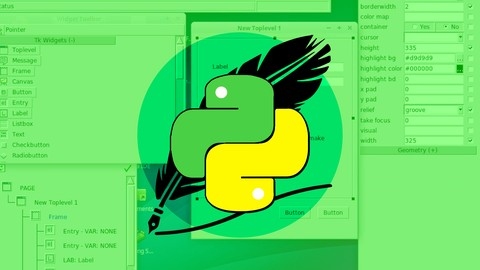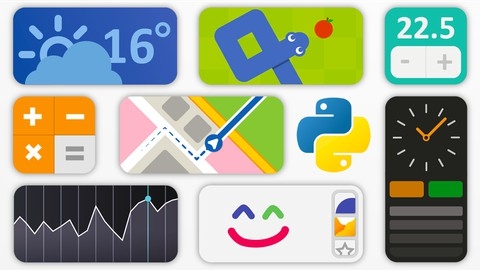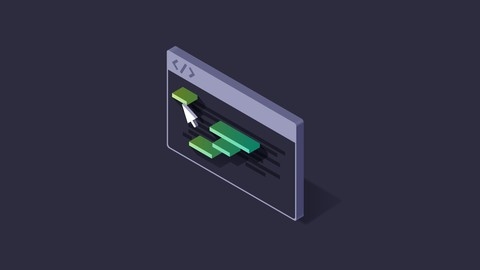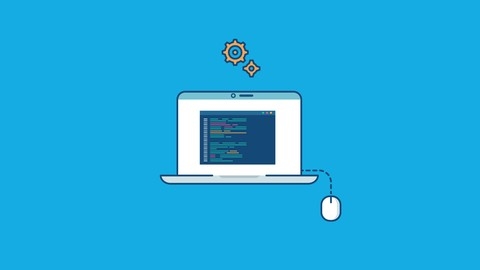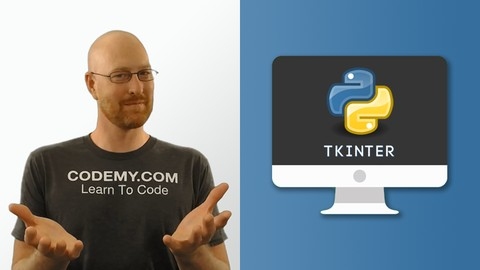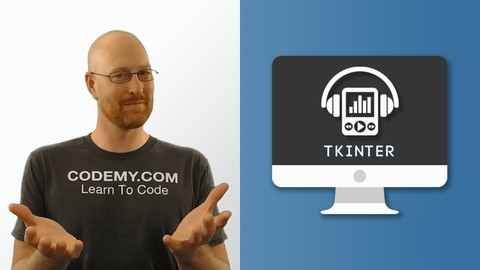Tkinter is a powerful Python library that allows you to create graphical user interfaces (GUIs) with ease.
It’s a popular choice for beginners due to its simplicity and flexibility, making it ideal for building a wide range of applications, from simple calculators to complex data visualization tools.
Learning Tkinter can open doors to exciting projects, enabling you to bring your Python code to life with visually appealing and interactive interfaces.
Finding the right Tkinter course on Udemy can be a challenge, with so many options available.
You’re searching for a course that goes beyond the basics, providing practical examples and hands-on projects to solidify your understanding.
Based on our analysis, Learn Python by creating 10 apps with tkinter is the best Tkinter course overall on Udemy.
This comprehensive course combines theoretical knowledge with practical application, guiding you through the creation of 10 real-world applications.
You’ll learn to build a variety of projects, from simple calculators and BMI trackers to more advanced applications like a Snake game and a map viewer.
This hands-on approach ensures you develop a deep understanding of Tkinter and gain valuable skills for any Python developer.
However, there are other fantastic Tkinter courses available on Udemy.
Keep reading to discover our recommendations for different learning styles, goals, and skill levels, and find the perfect course to fuel your Tkinter journey.
GUI Development with Python and Tkinter
You’ll start by diving deep into the core concepts of Python, covering essential topics such as variables, data structures (lists, tuples, sets, dictionaries), conditional statements, loops, and functions.
The curriculum also includes a thorough introduction to object-oriented programming, which will enable you to write modular and reusable code.
Once you’ve grasped the fundamentals of Python, the course seamlessly transitions to the world of Tkinter.
You’ll learn how to create basic Tkinter windows, manipulate widgets like buttons, labels, and text boxes, and explore more advanced widgets such as checkboxes, radio buttons, and comboboxes.
The course covers layout management using the Grid geometry manager, allowing you to create visually appealing and well-organized GUIs.
You’ll gain valuable knowledge on Tkinter styling and event handling, empowering you to design user-friendly interfaces.
The curriculum includes two comprehensive milestone projects: a distance converter application and a Pomodoro timer.
These projects will provide practical experience in applying your newfound Tkinter skills to real-world scenarios.
Finally, the course concludes with a section on packaging and distributing your Tkinter applications as standalone executables, ensuring that you can share your creations with others.
This comprehensive approach ensures that you’ll not only learn the core concepts of Python and Tkinter but also gain the practical skills necessary to build and deploy your own GUI applications.
Python Tkinter Masterclass - Learn Python GUI Programming
This Python Tkinter Masterclass appears to be a comprehensive and well-structured introduction to building graphical user interfaces (GUIs) using Python.
You’ll start with the fundamentals, learning how to use essential Tkinter widgets like labels, buttons, and entry fields.
The course then guides you through advanced widgets such as checkboxes, radio buttons, and combo boxes, along with techniques for arranging them using Grid Layout.
What stands out is the emphasis on hands-on experience through projects.
You’ll build a Calculator and a Text Editor, applying your knowledge to create real-world applications.
The syllabus also covers integrating databases, which will enable you to build more complex applications like an Address Book and Library Management System.
Beyond the core features, you’ll dive into using images, menus, scrollbars, and dialog boxes to create visually appealing and functional applications.
While the syllabus doesn’t offer a specific level of prior experience needed, it’s well-suited for both beginners and those with some prior programming experience.
However, it’s important to note that the syllabus is very comprehensive.
If you are new to Python, you may find it helpful to first gain a foundational understanding of Python programming concepts before delving into Tkinter.
You can expect to gain valuable knowledge and practical experience to create your own custom GUI applications.
Learn Python by creating 10 apps with tkinter
You’ll start with a solid foundation in Python programming, covering essential concepts like variables, functions, data structures, and flow control.
The course doesn’t shy away from practical examples, so you’ll quickly grasp how to apply your knowledge to build real-world applications.
You’ll then dive headfirst into Tkinter, learning how to create interactive user interfaces (GUIs) with widgets like buttons, dropdowns, and canvases.
The course guides you through different layout techniques like pack, grid, and place, empowering you to create visually appealing and responsive applications.
You’ll also explore various styling techniques, including using themes like ttkbootstrap to give your applications a polished professional look.
The true highlight of this course is the hands-on experience you’ll gain building ten engaging applications.
You’ll learn by doing, building everything from a simple BMI calculator and a fun snake game to more complex applications like a map viewer and an image editor.
You’ll tackle tasks like file handling, image manipulation, and even adding animation to your projects.
This approach ensures you develop a deep understanding of Python and Tkinter while gaining valuable, practical skills for any programmer.
The course’s focus on real-world applications is a strong selling point, providing you with a solid foundation for building your own applications in the future.
The Art of Doing: Create 10 Python GUIs with Tkinter Today!
You’ll embark on a journey to master Tkinter, a powerful Python library for building graphical user interfaces (GUIs).
This comprehensive course starts by equipping you with the fundamental tools: Python and Visual Studio Code.
You’ll delve into the core concepts of Tkinter, exploring widgets like labels, buttons, frames, and entries.
You’ll also gain a solid grasp of layout systems like pack and grid, allowing you to arrange elements effectively within your GUIs.
Through a series of practical projects, you’ll solidify your understanding.
You’ll start with simple applications like “Hello GUI World” and “Metric Helper,” gradually progressing to more complex ones like “Simple Checklist,” “Simple Calculator,” and “Notepad.”
As you move forward, you’ll tackle more ambitious projects, like creating a “Color Theme Maker” and a “Morse Code Translator,” where you’ll learn to manipulate colors, text, and even sounds.
The course then ventures into game development with the “Simon Memory Game” and “Gravity Simulation,” showcasing the dynamic capabilities of Tkinter.
Later stages will introduce you to the world of APIs (Application Programming Interfaces).
You’ll create a “Weather Forecast” app that retrieves real-time weather data and an “APOD Viewer” (Astronomy Picture of the Day) that displays stunning images from space.
You’ll learn to leverage the “Open Weather API,” adding a layer of interactivity and real-world data to your applications.
Finally, you’ll learn to use “Auto Py To Exe” to package your Tkinter creations into executable files (".exe").
This empowers you to share your work with others, making your applications accessible to a wider audience.
The Ultimate Tkinter Course: GUI for Python projects
You’ll begin by setting up your environment with Python, Tkinter, and Jupyter Notebook, then dive headfirst into creating your first GUI.
You’ll learn to add text, position elements using geometry managers, and build interactive elements like buttons, text inputs, and frames.
As you progress, you’ll tackle more advanced concepts like using the grid layout manager to organize your GUI elements, binding functions to events for dynamic behavior, and even creating a click counter.
You’ll also dive into object-oriented programming (OOP) with classes and menus, which are essential for structuring complex GUIs.
You’ll discover the power of the canvas to draw shapes, build a basic paint program, and even integrate scales for interactive input.
You’ll also explore advanced features like message boxes, dynamically creating and styling widgets, and customizing your GUIs to the highest degree.
To solidify your skills and build real-world experience, the course includes a bonus section on portfolio projects.
You’ll get to create a “Find the Treasure” game, putting your newfound knowledge into practice and creating a compelling project for your portfolio.
Intro To TKinter for Python GUI Apps
You’ll start with the essentials – installing Python and tools like Gitbash and Sublime.
Then, you’ll dive into the heart of Tkinter, learning to build interactive GUIs with widgets like labels, buttons, and entry boxes.
You’ll master layout managers like Pack and Grid, giving you precise control over the arrangement of your UI elements.
The course goes beyond the basics, teaching you to add sophisticated features like menus, frames, and status bars.
You’ll also learn about handling user input with radio buttons, checkboxes, and pop-up message boxes.
The course covers practical skills like opening file dialogs, implementing color pickers, and working with images.
You’ll put your Tkinter knowledge to the test by building a fully functional Flashcard App.
This project will teach you how to generate random numbers, handle user interaction, and implement various mathematical operations within your app.
You’ll also learn how to manage frame elements and create a visually appealing start screen.
This course is a valuable resource for anyone who wants to learn Tkinter and gain the skills to develop their own graphical applications.
The step-by-step approach, combined with the practical Flashcard App project, provides a solid foundation for building more complex GUIs in the future.
Build An MP3 Player With Python And TKinter GUI Apps
You’ll start by setting up your development environment, installing Python, Sublime Text, and Git Bash.
The instructor then walks you through the creation of your first Tkinter program, guiding you through building the basic application structure, including the playlist box and adding song menubars.
You’ll learn how to use the FileDialog box to select songs and clean up messy file paths.
The course dives into creating visually appealing buttons using images and even adding custom colors to your playlist.
You’ll learn how to delete songs from your playlist and create a robust player using Pygame.
You’ll cover essential functionalities like playing, stopping, pausing, and skipping songs, as well as implementing a status bar that displays the current song time.
The course features a detailed exploration of sliders, allowing you to control volume and song position, and you’ll learn how to seamlessly integrate these sliders with the player’s functionality.
It’s a practical learning experience that can be a valuable addition to your coding skillset.
However, be aware that this course primarily focuses on the practical aspects of building the MP3 player, so you might want to supplement it with additional resources if you’re looking for a deep dive into the underlying theory of Tkinter or Pygame.
Python GUI Programming
You’ll learn to build user interfaces from scratch, starting with the fundamentals of creating a basic window and customizing its size and position.
Right away, you’ll learn to add elements like labels, buttons, and text boxes, mastering techniques like grid and place methods to control their layout.
As you progress, you’ll encounter more advanced concepts, including creating multiple windows, building a menu bar, and adding interactive elements to menu lists.
The course delves into practical applications of Tkinter, showing you how to utilize the Message Box to display information to your users.
You’ll learn essential Tkinter functions and explore features like color choosers, allowing you to select colors within your application.
You’ll also learn how to prompt the user to open a file and then read the contents of that file within your GUI.
To make your GUIs more engaging, you’ll learn to implement radio buttons and check buttons.
The course provides practical examples of using these elements in various scenarios, helping you solidify your understanding.
You’ll also learn about the Entry class, creating text boxes that allow users to input information.
The course even includes a practical example of converting gallons to liters, illustrating these concepts in a real-world context.
This course provides a structured approach to learning Tkinter, covering essential features and practical applications.
You’ll emerge with a strong understanding of Python GUI programming and be ready to build your own interactive applications.


